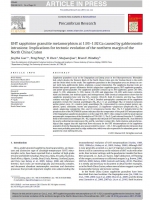Добрый день, Коллеги. Важное сообщение, просьба принять участие. Музей Ферсмана ищет помощь для реставрационных работ в помещении. Подробности по ссылке
UHT sapphirine granulite metamorphism at 1.93-1.92 Ga caused by gabbronorite intrusions: Implications for tectonic evolution of the northern margin of the North China Craton
Sapphirine granulites occur in the Daqingshan and Jining areas in the Palaeoproterozoic Khondalite belt, which divides the Western Block of the North China Craton into the Yinshan block to the north and the Ordos block to the south. The sapphirine granulites in the Daqingshan area are always in contact with meta-gabbronorite dykes, implying a causal relationship. The sapphirine-bearing rocks are divided into spinel-garnet-sillimanite-biotite-plagioclase-sapphirine gneiss, UHT sapphirine granulite, and spinel-garnet granulite. The sapphirine granulite contains up to 30% sapphirine, garnet (30-50%), spinel (5-15%), sillimanite (5-15%), biotite (10-20%) and plagioclase (10-20%) with minor cordierite, rutile and ilmenite, but without quartz and orthopyroxene. Bulk chemical compositions show that the sapphirine granulites have very low SiO2 contents (39wt.%), high Al contents, and low XMg. Biotite contains very high TiO2 contents up to 7.6wt.%. Detailed petrographic examination of the sapphirine granulites reveals five mineral assemblages (M0-M4): (1) an assemblage (M0) of mineral inclusions within garnet cores, (2) a matrix (peak) assemblage (M1) represented by coarse-grained garnet, sapphirine, spinel, sillimanite, biotite and plagioclase, (3) sapphirine + plagioclase symplectite (M2), (4) spinel + plagioclase symplectite (M3), and (5) retrogressive biotite (M4). The P-T stability field in the pseudosection of the NCKFMASH system indicates that the temperature of the peak UHT metamorphism of the Daqingshan sapphirine granulites is in the range 910-980 ° C (this compares with the peak regional metamorphic temperature of the khondalites of 700-820 ° C). The P-T path inferred from the P-T stability fields of the mineral assemblages (M1 -M4) suggests that the peak UHT metamorphism (M1) was followed by nearly isothermal decompression (M2 and M3) and later cooling (M4). Field relations and geochrono-logical data suggest that the high-heat flow necessary for the UHT metamorphism of the sapphirine granulites from the Daqingshan area was provided by coeval ~1.93-1.92 Ga gabbronorite intrusions that were most probably generated by ridge subduction, which was also responsible for abundant garnet-rich granites by crust melting the area.




